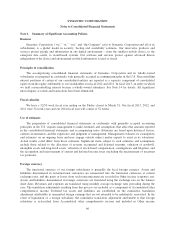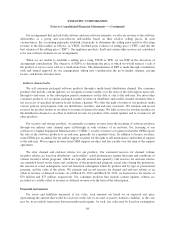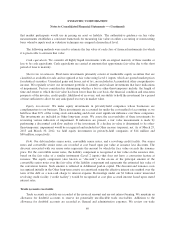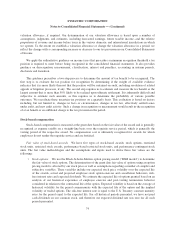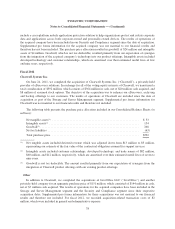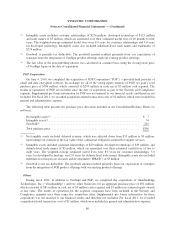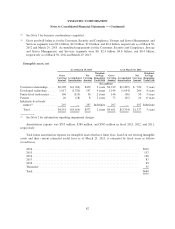Symantec 2013 Annual Report Download - page 174
Download and view the complete annual report
Please find page 174 of the 2013 Symantec annual report below. You can navigate through the pages in the report by either clicking on the pages listed below, or by using the keyword search tool below to find specific information within the annual report.SYMANTEC CORPORATION
Notes to Consolidated Financial Statements — (Continued)
Recently issued authoritative guidance
In December 2011, the Financial Accounting Standards Board (“FASB”) issued an accounting standards
update that will require us to disclose information about offsetting and related arrangements associated with
certain financial and derivative instruments to enable users of our financial statements to better understand the
effect of those arrangements on our financial position. In January 2013, the FASB issued another update to
clarify the scope of the related instruments, in which the standard applies to bifurcated embedded derivatives,
repurchase and reverse repurchase agreements, and securities borrowing and lending transactions. The new
guidance will be applicable to us on a retrospective basis in the first quarter of fiscal 2014. We do not expect that
this guidance will materially impact our disclosures included in our Consolidated Financial Statements.
In January 2013, the FASB issued an accounting standards update that will require us to release cumulative
translation adjustment (“CTA”) into earnings when an entity ceases to have a controlling financial interest in a
subsidiary or group of assets within a consolidated foreign entity and the sale or transfer results in the complete
or substantially complete liquidation of the foreign entity. For sales of an equity method investment in a foreign
entity, a pro rata portion of CTA attributable to the equity method investment would be recognized in earnings
upon sale of the investment. When a parent entity sells either a part or all of its investment in a consolidated
foreign entity, CTA would be recognized in earnings only if the parent no longer has a controlling financial
interest in the foreign entity as a result of the sale. In addition, CTA would be recognized in earnings upon a
business combination achieved in stages. The update will be effective, on a prospective basis for events
beginning in our 2015 fiscal year and applies to all interim periods. We do not expect that this guidance will
materially impact our consolidated financial statements.
In February 2013, the FASB issued an accounting standards update that requires entities to present
reclassifications by component when reporting changes in Accumulated other comprehensive income (“AOCI”)
balances. For significant items reclassified out of AOCI to net income in their entirety, entities are required to
report the effect on the line items in the Income Statement, either on the face of the Income Statement or in the
notes. For significant items not reclassified to net income in their entirety, entities must cross-reference in the
notes to the other disclosures that already provide information about those amounts. This new guidance will be
adopted in the first quarter of fiscal 2014 on a prospective basis. We do not expect that this guidance will
materially impact our consolidated financial statements.
Note 2. Fair Value Measurements
For assets and liabilities measured at fair value, such amounts are based on an expected exit price
representing the amount that would be received on the sale of an asset or paid to transfer a liability, as the case
may be, in an orderly transaction between market participants. As such, fair value may be based on assumptions
that market participants would use in pricing an asset or liability. The authoritative guidance on fair value
measurements establishes a consistent framework for measuring fair value on either a recurring or nonrecurring
basis whereby inputs, used in valuation techniques, are assigned a hierarchical level. The following are the
hierarchical levels of inputs to measure fair value:
•Level 1: Observable inputs that reflect quoted prices (unadjusted) for identical assets or liabilities in
active markets.
•Level 2: Observable inputs that reflect quoted prices for identical assets or liabilities in markets that
are not active; quoted prices for similar assets or liabilities in active markets; inputs other than quoted
prices that are observable for the assets or liabilities; or inputs that are derived principally from or
corroborated by observable market data by correlation or other means.
76


